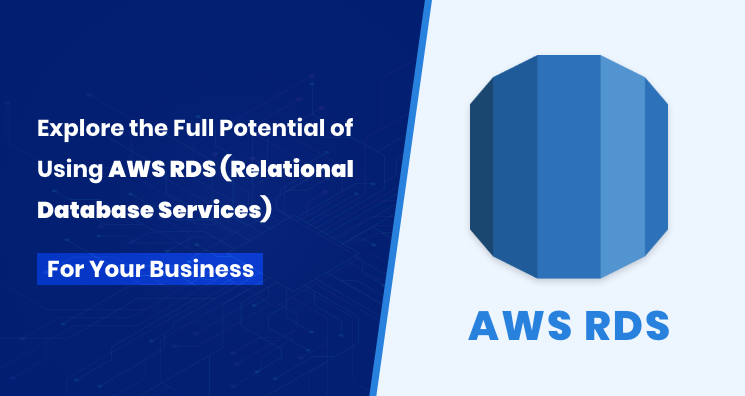Summary: This blog discusses the complete aspects of using AWS RDS (Relational Database Services) to meet your business growth requirements. It guides entrepreneurs to understand the business value of AWS RDS and choose it for storing their business-critical data.
AWS RDS is a cloud-based service that allows you to launch, operate, and scale a relational database with just a few clicks. By using the AWS database management service, you can enjoy all the benefits of AWS infrastructure without worrying about the maintenance or management of relational databases.
This is very important in today’s day and age when organizations want to focus more on product development and innovation where technology plays an important role in boosting revenues, whereas running database infrastructure consumes a lot of time which frustrates them.
When it comes to databases, there’s no better place to be than AWS. In this blog post, we’ll take a closer look at Amazon Relational Database Service(RDS). Here, we will study several such aspects to create better awareness among the readers with regards to using Amazon RDS to meet their business growth requirements.
Table of Contents
- –> A Brief History of AWS
- –> What is Amazon RDS in AWS(Amazon Web Services)?
- –> Some Facts and Figures
- –> How AWS RDS Can Meet Business Requirements?
- –> What Are The Advantages of RDS?
- –> Why everyone should look at using AWS RDS for their databases
- –> Future of RDS
- –> A Perfect Alternative – Nuclay Solutions
- –> Conclusion
A Brief History of AWS
The story of AWS started in the early 2000s, where Amazon was just another eCommerce platform with scaling issues. The company decided to create internal solutions to deal with the exponential growth they were facing. This laid the groundwork for AWS. It was a solution that was beneficial to developers and created an efficient infrastructure.
Image Source: Wikimedia
The genesis of Amazon Web Services (AWS) began specifically in the summer of 2003. It started as a distributed computing business, running computations on Amazon computers and getting paid for it.
AWS was part of a research project called “Amazon Industrial Farm”. It began as an infrastructure service with S3, its highly durable storage cloud, and EC2 instances which provided virtual computer infrastructure with a way to access various services from the internet.
Now it’s the backbone of every business in everything related to the cloud. AWS provides the products with the power, reliability and availability required to run a global business like Amazon. But it doesn’t stop there – Amazon is constantly innovating so that AWS can deliver fresh and improved services to all customers.
What is Amazon RDS in AWS (Amazon Web Services)?
If you’ve been looking for an easy and reliable way to set up a relational database in the cloud, Amazon RDS is your answer. It provides scalable DBMS for maximum flexibility and cost-effectiveness. By using Amazon RDS, you can create a highly available, fault-tolerant, scalable database with the click of a button.
AWS relational databases can store your mission-critical data in a scalable environment that delivers high database performance and availability with fast, cost-effective solutions. When you choose Amazon RDS for your production database, you can sleep easy knowing that the database engine is protected from hardware failures by continuously monitoring its health.
Now that you have a mild idea about Amazon RDS, let us look at some numbers supporting the cloud database.
Some Facts and Figures
Check out these amazing numbers that predict the relevance of AWS RDS in the future and showcase the importance of Amazon RDS in the present economy:
- 1) According to InfoClutch, AWS has the highest market share of 32.1% in relational databases services in the world. They also say that there are currently 2,381 companies using Amazon RDS to date.
Image Source: InfoClutch
- 2) According to MarketandMarkets and BusinessWire, the global cloud database and Database-as-a-Service (or DBaaS) will grow from USD 12.0 Billion in 2020 to USD 24.8 billion by 2025. It is increasing at a Compound Annual Growth Rate (or CAGR) of 15.7%, which is quite high.
- 3) According to research by IDC, there is 86% faster deployment of new databases using Amazon RDS. The white paper also concluded that companies faced 97% less unplanned downtime using Amazon Relational Database. Most of the organizations got their money returned to them in revenue after the first five months.
How AWS RDS Can Meet Business Requirements?
Here are some reasons that help your business be more successful using Amazon relational database service:
- #1 High availability: RDS is a relational database service with multiple availability zones that operate independently, allowing applications to scale smoothly even when underlying database clusters experience failures.
- #2 Flexible Resource Consumption: Amazon RDS allows you to create an infrastructure using your own AWS resources, which makes it easier for you to set up a full-featured database in minutes. Amazon RDS is designed for simplicity so you can focus on your application development.
- #3 Increases Productivity: Amazon RDS lets you use your existing IT resources to save time and effort when deploying, managing, and supporting your database infrastructure on AWS. Since there’s less work for your DBA team, they can focus their energy on other projects that will help meet business needs. And more time and flexibility isn’t just good for IT, it also reduces implementation costs and helps developers deliver additional features faster.
- #4 Reduces Infrastructure Cost: We all know that moving to the cloud can be risky. But you can reduce your infrastructure costs without sacrificing performance with Amazon RDS. With flexible usage-based pricing, pay as you go with no long-term commitments. That means you’ll never have to pay for idle capacity and no upfront hardware or software expenses, ever.
- #5 Risk Mitigation: Amazon RDS is a technology that is battle-tested over several decades. The AWS Relational Database System is a managed service, with backups and snapshots that are automated and continuously updated, so there is a limited impact of outages on employees and business operations.
- #6 Increases Business Productivity: Amazon RDS allows businesses to focus on their core business rather than managing the database. This improves business performance and productivity. Your business becomes more flexible and free. You can add more workers and software without adding to the budget.
- #7 Drives Innovation: The freed staff can be useful in improving the performance of your website, accelerating innovation, and developing a new application. The more experienced personnel can support databases efficiently, with no need for doing the mundane, mechanical tasks that they used to do before Amazon RDS.
- #8 Reduces Engineering Time: AWS RDS helps you reduce the time your team spends on database management, development, and deployment. With AWS relational database service, enterprises can run applications without worrying about the potential cost and time commitment to updating their hardware and software stacks.
What Are The Advantages of RDS?
Following are some advantages of implementing AWS relational database service to your IT infrastructure. It offers a brief view into the very advantages that make many businesses succeed in a short time.
- –> Easy to Administer: Amazon RDS makes it easy to set up, operate, and scale your database deployments in the cloud. You can launch a fully configured database instance in minutes with just a few clicks.
- –> Works Without A DBA: Amazon RDS reduces the need to deal with a dedicated human just to get a database up and running. AWS Relational Database System can deploy your application with just your AWS credentials and allows using existing databases without needing to set up a DBA.
- –> Consistent Performance: RDS provides you with better performance and availability than a traditional DB instance. With the ability to choose your storage, add more CPU or RAM, and connect to other AWS services such as the ElastiCache In-Memory Database Cache, you can run your workloads in the cloud the way you want.
- –> Secure: Amazon RDS is a certified secure and reliable hosting solution for your database applications. Your data is encrypted and protected by AWS’s Multi-Factor Authentication, which requires users to verify their identities via one or more methods. You can also monitor access history and set up alerts to receive notifications about changes to database security.
- –> Affordable: Relational Database Service (RDS) in the AWS Cloud offers DB instance sizes designed to provide cost-effective storage and compute capacity for a variety of workloads. With RDS, you gain access to computing capacity on-demand, without making any upfront investments. Run mission-critical analyses and deliver real-time results.
- –> It is Fast: A fast, web-scale relational database service with reliable performance and high availability. You can launch a medium-sized RDS instance in less than 50 seconds. It’s easy to manage and built for mission-critical workloads.
- –> Comprehensive: Amazon has made it easy to switch from your own IT equipment to AWS. This is because they’ve invested in training and education to teach you how to use their tools. Amazon offers an abundance of information on their website, including online documents with step-by-step instructions for working with AWS.
- –>Global Leaders: Amazon Web Services are global Leaders in the cloud with over 70 Availability Zones across 12 geographic regions. This enables you to deploy your applications faster, increase capacity without downtime, and innovate at warp speed.
Why Should Everyone Look at Using AWS RDS for Their Databases?
Below are some key points that will help you see the benefits of choosing relational database services from Amazon Web Services:
- * Universally Compatible: With Amazon RDS, you can configure your MySQL, PostgreSQL, Oracle, Microsoft SQL, or MariaDB database server in just a few minutes and scale it globally within minutes. If you are already familiar with your existing database, then it’s likely that migrating to RDS will be a relatively straightforward process.
- * Amazon’s Database Platform: Aurora is the new, fully-managed database service from Amazon RDS. With Aurora, you can deliver fast, high availability, and auto-scaling performance on demand. It is an open-source platform for building database applications in an easy and user-friendly way, has good performance, and uses fewer resources.
- * Automated Backups: With Amazon RDS, you need not worry about backups, as Amazon RDS will make automated instances for automatic backups. You can restore your data to a specific point in time with no hassle. You can even restore individual items instead of the entire DB instance—helping you manage costs and resources.
- *RDS Read Replicas: Amazon RDS Read Replicas give you the ability to create a read-only replica of your production database in about five minutes. You can then test how your applications perform when accessing your data from another location with fewer network hops.
- * Easier Maintenance: Amazon RDS enables you to automate patching of your database instances, up to once per day, reducing the risk that your application or customer data will be compromised by a security vulnerability.
- *Easily Scalable: RDS allows you to increase capacity quickly by taking advantage of your existing AWS resources. All you do is specify the number of instances that you want in your new resource group, Amazon RDS does the rest. It’s also easy to scale down if it turns out you don’t need the extra capacity.
- * Self-Detect Anomalies: Recognize and automatically repair early signs of critical, impending failures within your database. Amazon RDS Self-Detect Anomalies can detect issues at multiple points in the database management life cycle, including creating new instances, restoring from backups, and at runtime.
- * Easy-to-Use RDS Console: The Amazon RDS console provides a friendly interface to manage your relational database instances. The console is built upon the AWS Management Console, which uses the same authentication and security model you are familiar with and will require no additional user or administrator configuration.
Future of RDS
Think of Amazon RDS as an alternative way to do database computing. It’s a web service for managing relational databases that comprise storage, database engines, and database features that all work together seamlessly with AWS services like EC2. Here are some other advantages of AWS relational database in the future:
- #1 Replace Public Cloud Solutions: Many of the core database functionality available in Amazon RDS can be obtained in the AWS Cloud. By using Amazon RDS as a replacement for public cloud databases, customers have more flexibility to shift infrastructure in and out of the public cloud with minimal downtime.
- #2 Edge computing and IoT: Amazon RDS allows developers to build applications at a scale that’s 10x cheaper, easier and faster to develop than before. In the long term, the explosive growth of IoT data will promote the management of information outside of public clouds.
- #3 Bigger Scale of Data: The volume of data is exploding and the cost of maintaining a data centre is increasing. Most times, such local data will reach volumes similar only to centralized data centres. Amazon RDS will provide the solution that companies need to keep the cost and volume of data in check.
A Perfect Alternative – Nuclay Solutions
Nuclay Solutions provides AWS RDS professional services to entrepreneurs. We are a team of professional software engineers who provide AWS RDS solutions for startups and entrepreneurs. Nuclay Solutions helps clients bring a new product or service to market faster while reducing risk and cost. We handle all research, plans, development, deployment, monetisation and maintenance for our clients. In doing so, we make them look good while making sure that the project is done right the first time!
Conclusion
AWS RDS is a cost-effective option that will remove the need to invest in infrastructure to support large, heavy, and complex databases. Start using RDS today and see how easy it is to scale your database needs. For any queries or to share your project details, email us at info@nuclaysolutions.com.



